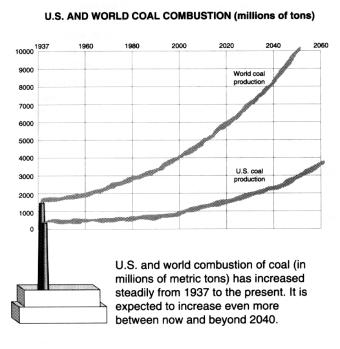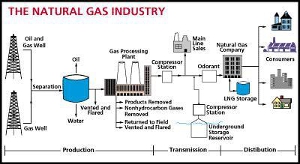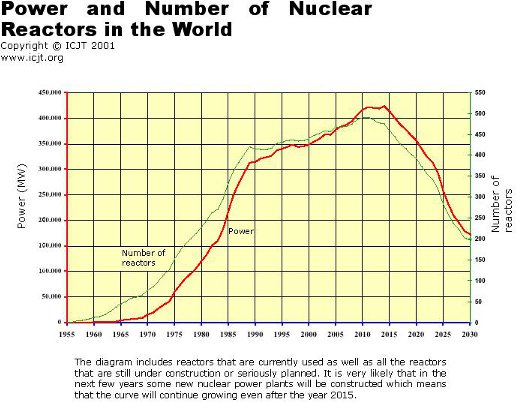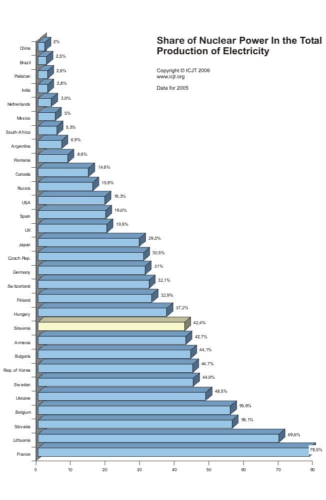- The Vitruvian Plant: Powering the Future #10-2284
-
Background
History of Nuclear Energy Nuclear Agencies and Regulations Nuclear Power in the Public Eye Economics of Nuclear Energy Radioactivity Basics Nuclear Reactor Basics Current Reactor Designs Processing Radioactive Materials Remote Handling Uses of Radiation Archimedes Filter Technology New Generation Reactors
- Components
- Project
Economics of Nuclear Energy
Ever since the Flintstonian-era of foot-powered cars, the search has been on for the best type of method to power society's needs. Complex industrial and economic markets have been built upon these needs throughout history as different ideals have been debated. The best investment for our present and future energy needs is a controversial topic. As different energy sources are discovered, governments enact laws and regulations on their use. As our power demands grow, so does our energy dependency. Fuel, it's what makes us go.
Sources of Energy
Coal
Coal is one of the most useful fuel sources mankind has ever discovered. Coal currently generates 27% of the world's primary energy and 41% of its electricity. While coal is used worldwide it is not found worldwide, only in a few select locations. The countries on top of these locations produce enough coal to export to countries without coal. Coal is in high demand so countries mine billions of tons of coal a year; the top four countries in 2008 were China who produced 2848 billion, The U.S. with 1172 billion, India with 568 billion, and the former USSR with roughly 563 billion. When burning coal inside coal-fired power plants 40% of the thermal energy can be changed into electricity. For every ton of coal 2460 kWh can be made. It is predicted that coal use will increase 50% by 2030 due to third world countries meeting electrical rates.Oil
Oil is the most important commodity in the world today. Oil is used to fuel all of our vehicles and so there is a high demand for it. Like coal, oil isn't found worldwide but in select locations and oil is in even higher demand than coal so countries with oil produce as much as they can. The top 4 countries that produce oil are Russia with 9,932,000 barrels a day, Saudi Arabia with 9,764,000 barrels a day, U.S. with 9,056,000 barrels a day, and Iran with 4,172,000 barrels a day. One barrel has 42 gallons of crude oil in it. Crude oil is basically useless but when it is refined the oil can be made into a plethora of different fuels and materials. One of the factors to oil's success is that 42 gallons of crude oil can be refined into 44 gallons of sellable product. One barrel of oil today costs about 77.62 dollars.
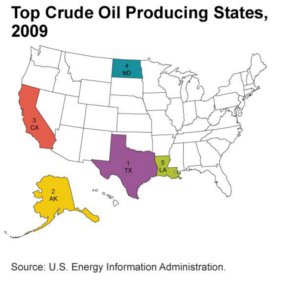
Image courtesy of US Energy Information Administration |
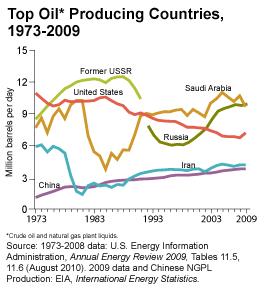
Image courtesy of US Energy Information Administration |
Natural Gas
Natural gas is also a major worldwide commodity, and like coal and oil it is only found in certain locations and the countries who own those locations export the natural gas to other countries. The top 4 countries that produce natural gas in 2009 are the U.S. with 593.4 billion cubic meters, Russia with 546.8 billion cubic meters, the European Union with 181.6 billion cubic meters, and Canada with 161.3 billion cubic meters. Currently the U.S. generates 25% of its energy from natural gas. Natural gas can become liquefied at -260 degrees F and put into tanks for easier storage. About 25,000 cubic meters can be stored inside a single tank. Natural gas costs 13.68 dollars per thousand cubic feet or 342 dollars for a whole tank of Natural gas.Nuclear Power
The use of nuclear power provides answers for many problems in the areas of the environment, safety, economics, reliability, sustainability, and even waste. Like fossil fuels, the nuclear fuel raw materials come from the Earth. Uranium, the primary fuel material, is mined. The environmental impact of mining is well known; however, the advantage of nuclear power comes from the amount of power that comes from a small amount of uranium. The power from one kilogram of uranium is approximately equivalent to 100,000 kilograms of oil; therefore, as a function of power consumption, very little uranium needs to be removed from the ground; hence, the environmental impact of uranium mines is much less compared with mining and drilling for fossil fuels.Nuclear power plants are one of the most economical forms of energy production. Nuclear fuel costs (as a function of power generation potential) represent only a fraction of the cost of fossil fuels. Including capital and non-fuel operating costs, the cost of operating a nuclear power plant is roughly equivalent to fossil fuels. Recently, the average electricity production cost for nuclear energy was recognized as the cheapest source of electricity. In 1999, the average cost of power generation by nuclear plants was 1.83 cents per kilowatt-hour, for coal-fired plants 2.07 cents, for oil 3.24 cents, and for gas 3.52 cents. Costs for solar and wind are still well beyond that considered to be competitive to the public.
Although final performance figures are not yet available, preliminary estimates for 2002 show that the nation's 103 nuclear power plants set an electricity production record for the fourth straight year, increasing their output 1-2 percent to about 778 billion kilowatt-hours (kwh). Nuclear power generation in 2001 was 769 billion kwh.The plants' average capacity factor-a measure of efficiency-reached a record high for the fifth straight year, climbing to about 91.5 percent in 2002. "By any measure-reliability, productivity, safety, economics-the nuclear energy sector has achieved major gains in recent years," said Don Hintz, president of Entergy Corp. and chairman of the Nuclear Energy Institute's (NEI) board of directors.
Since 1990, the industry's sustained excellence in operating performance has enabled the nation's reactors to increase electricity production equivalent to what 25 new reactors would add to the electricity grid, NEI President and Chief Executive Officer Joe F. Colvin said. "In just the last five years, the increase in output is equivalent to 13 new 1,000 megawatt power plants," Colvin said.
With improved productivity and reliability leading to better economic performance, the average production cost (fuel costs plus operations and maintenance) in 2001 stood at a record low of 1.68 cents/kwh. The average production cost for 2002 likely will set a new record when those figures become available later this year, Colvin said. "The value of nuclear energy remains incredibly strong. Nuclear power plants are providing competitively priced electricity that gives customers stability in future pricing, and they are doing so without polluting the air," Colvin said.
The cost of regulation and industry oversight of nuclear power generation is substantially more than that of other power generation sources; however, improvements in reliability and operational and maintenance efficiencies have contributed to reducing those costs. Currently, nuclear power plant capacity factors average over 75%. This is competitive with those of fossil fired plants. Most plants are designed to operate in a base load configuration; that is, they run at full power regardless of the demand on electricity. Nuclear power plants are particularly well suited for this purpose since they are designed to produce large quantities of power and can sustain operation for up to two years without refueling.
Nuclear Power Plant Employment
In the worst economic slump in decades, manufacturers of nuclear power equipment
gathered in Chattanooga Wednesday to talk about how to expand their production and
hire more workers to supply an expected revival in nuclear power. The Nuclear Energy
Institute estimates at least 20,000 construction jobs will be added to eight plants the industry
expects will begin construction by 2011. If all 26 of the reactors proposed to be
built in the United States move forward, NEI projects at least 62,000 construction
jobs will be created in the next decade, including several thousand by the Tennessee
Valley Authority. Already, NEI estimates, more than $4 billion has been invested
in nuclear plant development, creating nearly 15,000 jobs. At TVA's Watts Bar Nuclear
Plant near Spring City, Tenn. TVA has 1,600 workers employed at the Unit 2 reactor,
including 680 contract engineers, 390 union craft workers, 430 support personnel
and 100 TVA employees. By the end of 2010, more than 2,300 workers will be employed
building the Unit 2 reactor.
NEI gives out there estimates of the amount of jobs that will be given to build nuclear reactor plants in 2011. In 2011 20,000 construction jobs are estimated to be added and 62,000 jobs in the next decade. As far as workers working in the plant, TVA has 1,600 employed, and by the end of this year the plant will have over 2,300 workers. With 900 extra jobs needed each year at the plant it means nuclear power is a more recommended power source.
A study projected employment needs created by growth and employee turnover for the nuclear power industry over the next decade. Only employment by electric utilities in the commercial generation of nuclear power was investigated. Employment data for 1981 were collected in a survey of 60 member utilities of the Institute of Nuclear Power Operations. The data were analyzed statistically to identify factors accounting for variations in power plant staffing and the number of off-site nuclear support personnel employed by a utility. Total employment in the nuclear power industry was predicted to increase from 54,400 in 1981 to 73,600 in 1991. Due to replacements, 36,300 additional employees would also be needed. As more power plants progress from design and engineering, through construction, and into full operation, more on-site employees will be needed. Megawatt capacity, number of reactor units, operation status, and projected completion dates for units under construction were identified as factors influencing the number of employees at a power plant site. Number of off-site personnel was influenced by total megawatt capacity in operation, total megawatt capacity under construction, projected completion dates for units under construction, and whether or not the utility industry does its own architect-engineering work. (Appendixes, amounting to approximately one-half of the report, include questionnaires, technical notes, and utility-projected 1991 employment.) (YLB)
Data from a study estimating the number of nuclear power plant jobs in 1981 and there predictions on the change of employment over a decade.
The Point Beach Nuclear Power Plant currently has approximately 660 full-time employees.FPL Energy has agreed to retain non-bargaining unit employees at Point Beach at comparable wages and benefits for 18 months following the close of the sale. In addition, FPL Energy will honor all labor agreements for bargaining unit employees.
There are exactly 660 full-time employees at the Point Beach Nuclear Plant.
NEI gives out there estimates of the amount of jobs that will be given to build nuclear reactor plants in 2011. In 2011 20,000 construction jobs are estimated to be added and 62,000 jobs in the next decade. As far as workers working in the plant, TVA has 1,600 employed, and by the end of this year the plant will have over 2,300 workers. With 900 extra jobs needed each year at the plant it means nuclear power is a more recommended power source.
A study projected employment needs created by growth and employee turnover for the nuclear power industry over the next decade. Only employment by electric utilities in the commercial generation of nuclear power was investigated. Employment data for 1981 were collected in a survey of 60 member utilities of the Institute of Nuclear Power Operations. The data were analyzed statistically to identify factors accounting for variations in power plant staffing and the number of off-site nuclear support personnel employed by a utility. Total employment in the nuclear power industry was predicted to increase from 54,400 in 1981 to 73,600 in 1991. Due to replacements, 36,300 additional employees would also be needed. As more power plants progress from design and engineering, through construction, and into full operation, more on-site employees will be needed. Megawatt capacity, number of reactor units, operation status, and projected completion dates for units under construction were identified as factors influencing the number of employees at a power plant site. Number of off-site personnel was influenced by total megawatt capacity in operation, total megawatt capacity under construction, projected completion dates for units under construction, and whether or not the utility industry does its own architect-engineering work. (Appendixes, amounting to approximately one-half of the report, include questionnaires, technical notes, and utility-projected 1991 employment.) (YLB)
Data from a study estimating the number of nuclear power plant jobs in 1981 and there predictions on the change of employment over a decade.
The Point Beach Nuclear Power Plant currently has approximately 660 full-time employees.FPL Energy has agreed to retain non-bargaining unit employees at Point Beach at comparable wages and benefits for 18 months following the close of the sale. In addition, FPL Energy will honor all labor agreements for bargaining unit employees.
There are exactly 660 full-time employees at the Point Beach Nuclear Plant.
Cost Analysis of Running a Nuclear Power Plant
Advantages of Nuclear Power
Nuclear power plants have significant advantages over other conventional forms of energy, such as coal and gas powered plants. Compared to other sources of energy, Nuclear energy produces significantly less green house gases. Because global warming is a growing concern in today's society, nuclear energy appears as reliable alternative as opposed to other sources of energy. Nuclear power also uses their fuel more efficiently. In a gas-fired plant 80% of the plant's cost will be invested into fuel, while in a nuclear power plant 10% will be invested into uranium, the primary fuel of nuclear power. Because of uranium's efficiency, nuclear power plants can achieve the equivalent amount of energy output, while at the same time using less fuel.
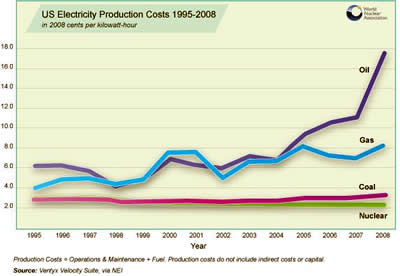
Image courtesy of: The World Nuclear Association |
Costs of Constructing a Nuclear Power Plant
Although nuclear energy is much more efficient than other conventional methods it is still significantly more expensive. It is estimated that that a nuclear power will cost approximately £1.5 billion to £2.25 billion, while a coal powered plant will cost around £800 million to £1 billion. In today's economy, nuclear power plants can be constructed by constructing them in a "bulk" manner, meaning that making multiple plants can prove significantly cheaper costs than building one or a few, but it is still considerably more expensive as compared to constructing coal plants. The cost of producing electricity in a Nuclear power plant is about $1400 per Kilowatt; however in the United States the electricity cost is estimated at about $3500 per Kilowatt in any new plant that will be built. The cost of running a Nuclear power plant, though, is predicted to decrease over time, as it has done in the past. Since 1987, the cost of running a Nuclear power plant has decreased from 3.63 cents per Kilowatt hour to 1.68 cents per kilowatt hour in 2004. Along with the decrease of cost, availability of nuclear power increased with it. From 1987 to 2004 availability increased from 67% to over 90%, establishing Nuclear power as one of the top energy sources in the world.Archimedes Plasma Mass Filter
http://epsppd.epfl.ch/StPetersburg/PDF/O1_006A.PDF
Chattanooga: Nuclear plants could prove bright spot
http://www.timesfreepress.com/news/2009/feb/19/chattanooga-nuclear-plants-could-prove-bright-spot/
Coal Combustion: Nuclear Resource or Danger
http://www.ornl.gov/info/ornlreview/rev26-34/text/colmain.html
Coal and Jobs in the United States
http://www.sourcewatch.org/index.php?title=Coal_and_jobs_in_the_United_States
Cost of Nuclear Power
http://nuclearinfo.net/Nuclearpower/WebHomeCostOfNuclearPower
Cost of oil falls amid Wall Street, China worries
http://www.msnbc.msn.com/id/12400801/
EIA Frequently Asked Questions
http://www.eia.doe.gov/ask/crudeoil_faqs.asp
Economics of Nuclear Power
http://www.world-nuclear.org/info/inf02.html
Electricity: Benefits/Effects
http://www.aboutnuclear.org/view.cgi?fC=Electricity,Benefits_%5E_Effects
FPL Energy announces agreement to purchase Point Beach Nuclear Power Plant
http://www.nexteraenergy.com/news/contents/2006/122006.shtml
How much coal is required to run a 100-watt light bulb 24 hours a day for a year?
http://science.howstuffworks.com/environmental/energy/question481.htm
Manpower Requirements in the Nuclear Power Industry, 1982-1991
http://www.eric.ed.gov/ERICWebPortal/search/detailmini.jsp?_nfpb=true&_&ERICExtSearch_SearchValue_0=ED220682&ERICExtSearch_SearchType_0=no&accno=ED220682
Natural Gas Prices
http://www.eia.doe.gov/energyexplained/index.cfm?page=natural_gas_prices
Natural Gas Production by Country
http://geology.com/oil-and-gas/natural-gas-production-map/
Nonrenewable Natural Gas
http://www.eia.doe.gov/kids/energy.cfm?page=natural_gas_home-basics
Nonrenewable Oil(petroleum)
http://www.eia.doe.gov/kids/energy.cfm?page=oil_home-basics
Nuclear Power Plants Set Reliability, Output Records in 2002, Industry Tells Wall Street
http://www.nei.org/newsandevents/reliabilityoutputrecords2002/
Pros and cons of nuclear power
http://timeforchange.org/pros-and-cons-of-nuclear-power-and-sustainability
The costs of nuclear energy
http://news.bbc.co.uk/2/hi/business/7180539.stm
World Coal Association
http://www.worldcoal.org
